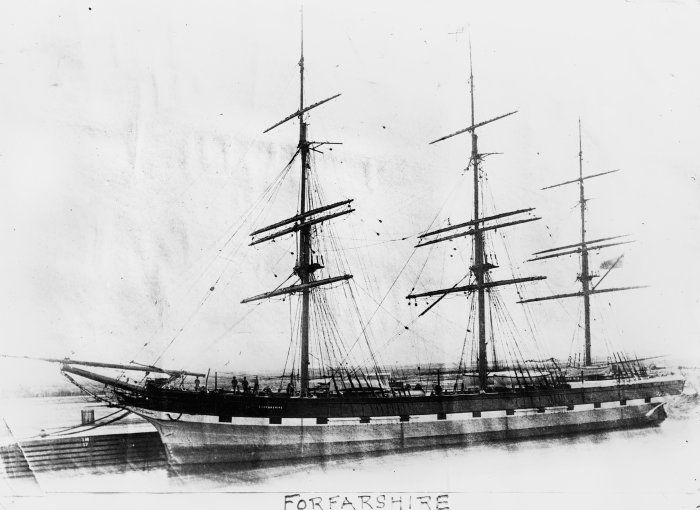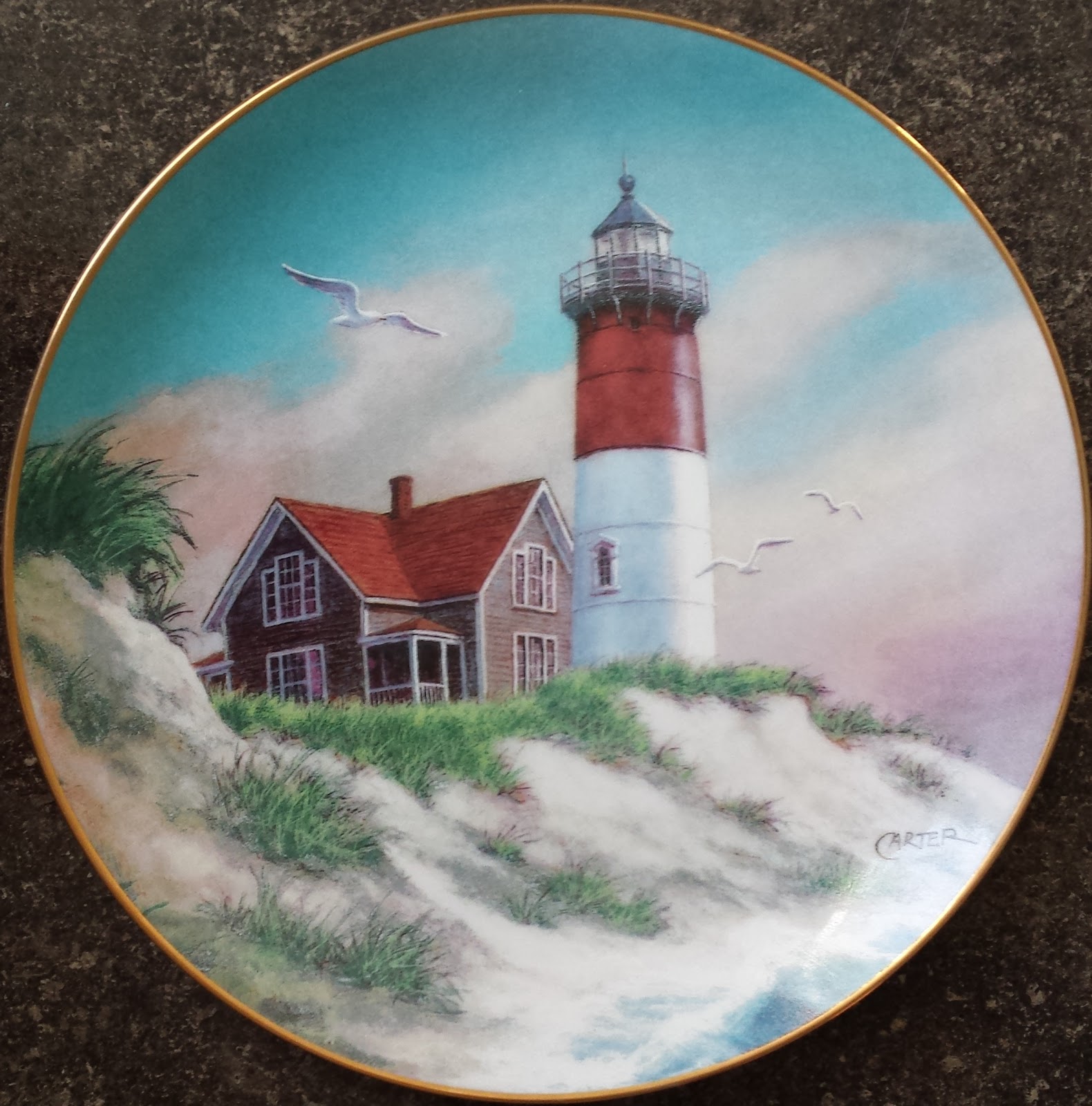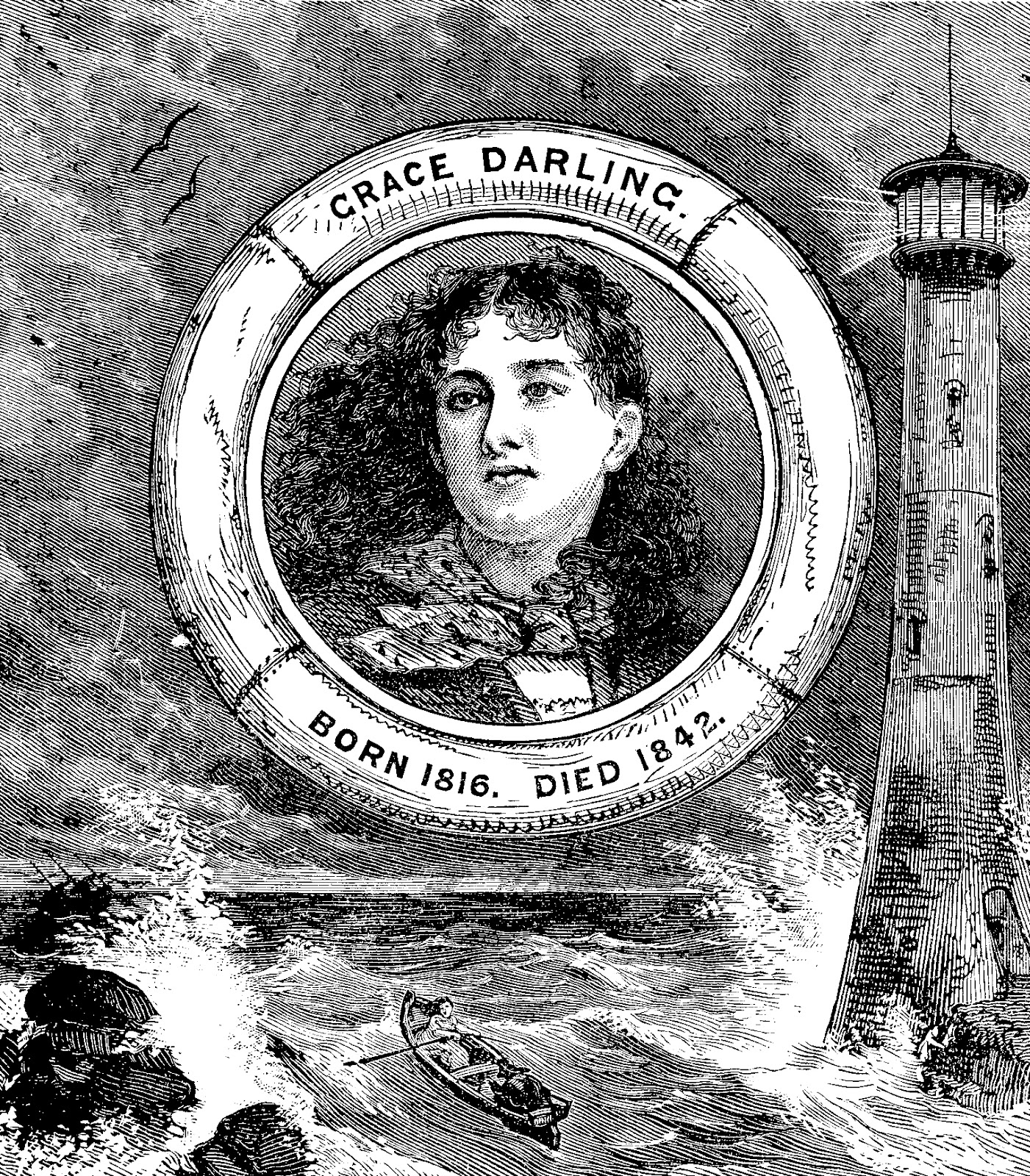In honor of Women's History Month, enjoy these articles.
Grace Darling
Extraordinary Rescuer or Media Heroine?
Elinor DeWire
‘Twas on the Longstone
light-house,
There dwelt an English maid;
Pure as the air around her,
Of danger ne’er afraid…
Cal Bagby,
“The Ballad of Grace Darling”
What lighthouse
enthusiast has not heard of Grace Darling, the daughter of an English
lighthouse keeper whose pluck and call to duty in 1838 resulted in the rescue
of the survivors of the wrecked steamship Forfarshire? Thanks to flowery
Victorian journalism and the British bent for fanfare, Grace’s single gallant
deed earned her immortality and made her, as biographer Jessica Mitford said,
“the first media heroine.” Yet, her story is barely a glimmer these days…not
the popular and embellished tale it was more than a century ago. Who was Grace
Darling really, and was she as heroic as history claims.
I first heard about
Grace Darling from my mother, a great reader and amateur historian who, though
she never visited England or
saw the tempestuous North Sea where Grace
gained fame, had learned the heroine’s story in books and girls’ magazines when
she was a child during World War I. One day when I was about seven, as we
browsed through a plethora of pretty Easter bonnets in Montgomery Ward’s, we
came across one with pink, ribbon ties called “Grace Darling.” Mother proceeded
to educate me about girls who were pretty and dainty but also tough as nails
and braver, sometimes, than their male peers. She remembered reading that Grace
Darling had been given an expensive bonnet after Grace became famous.
Grace’s story grew
from simple roots into florid blooms. At dawn on September 7, 1838, Grace and
her father, William Darling, the keeper of the 1826 Longstone Lighthouse in the
Farne Islands, awoke to the howl of wind and
crashing of waves against their ocean home. Spume filled the air as they looked
across the slate gray North Sea, a body of
water notorious for its storms. It was 4:45 a.m. In the distance the dim,
ghostly outline of a ship was seen in the quickening twilight, aground on Big
Harcar Rock almost a mile from the lighthouse. A telescope revealed survivors
clinging to the wreck.

Keeper Darling, in the
tradition of all lighthouse keepers, waited for low tide and greater daylight,
then donned his oilskins and downed a hot drink to steel himself for the
grueling task ahead—attempting a rescue of the survivors. The surfmen at North Sunderland (now called Seahouses) likely were not
able to reach the ship with their lifeboat. The survivors’ only hope was the
lightkeeper on Longstone.
His twenty-two-year-old
daughter, Grace, knowing her father needed help, asked to accompany him. She
was young and could handle a boat. The only other person at the lighthouse was
her mother, and the elder woman had less strength than Grace. Who knows what conversation
passed between Grace and her father? It was a miserable chore to push a small
boat into stormy seas. They knew they’d be risking their lives to save others.
But this was the way of God-fearing coastal people, especially on the North Sea where fishing, boat-building, and other
maritime trades dominated the economy. “You have to go out…” was their mantra.
Blankets were
gathered, and the lighthouse coble, a short, flat-bottomed boat 21½-feet long from stem to stern, was lowered
into the wild waters. Grace and her father were able rowers, but the
mountainous seas and violent tide pushed the stout little coble off course
several times, making the journey to the stranded ship twice as long. They
reached the wreck—the steamer Forfarshire—in
about an hour and Keeper Darling took off five of the nine survivors while
Grace steadied the coble. The boat could hold no more than seven safely, so once
loaded they rowed for the lighthouse. The lightkeeper and two of the rescued
seamen then made a second trip to the wreck to fetch the remaining survivors.
Grace did not accompany them this second time. Instead, she remained at the
lighthouse with her mother to help the castaways, one of whom was badly injured.

What makes Grace
Darling a heroine for this effort? It was, after all, only one trip to the
wrecked ship, with Grace merely rowing and steadying the boat. Her father did
the actual rescuing and made two trips to the wreck. It was strenuous, to be
sure, but the Darlings were skilled boat-handlers and observers of the sea.
According to a naturalist in Seahouses, “I shouldn’t think their lives were in
much danger.” Indeed, “The Deed,” as local Northumbrians call Grace’s act, might
not have been worthy of the fame that followed.
Several lighthouse
women later equaled or surpassed Grace Darling’s effort. The United States
had several “Grace Darlings.” Ida Lewis of Lime Rock Light in Newport, Rhode Island
is said to have single-handedly rescued more than dozen people, as well as a
small herd of drowning sheep that she flipped in her rowboat one at a time
using an oar. Diminutive Katie Walker of New York Harbor’s
Robbins Reef Light—less than five feet tall—is credited with more than fifty
rescues, all accomplished on her own. And teenage Abbie Burgess saved her invalid
mother and siblings during a terrible storm at Matinicus Rock, Maine,
then kept the twin lighthouses operating for more than a month when her father
was detained ashore.
Rescuing and other
acts of self-sacrifice were commonplace among light keeping families. Longstone
lightkeeper William Darling, had done it before and would do it again. It was
expected of his compassionate, solicitous occupation. To have his daughter help
him row to the wreck was nothing extraordinary. Lighthouse history is replete
with daughters who helped their fathers in myriad ways.
Shipwreck was
commonplace too, especially in the tumultuous North Sea
at the change of seasons. William Darling’s logbook entries for Longstone Lighthouse
mention several wrecks during his tenure alone. What was remarkable about the Forfarshire incident was not the
shipwreck or the rescue, but the sensationalism it created, and how with
lightning speed it transformed a quiet, shy, girl of twenty-two into a
celebrity.

Grace’s rapid rise to
fame was rooted in the Forfarshire
rescue, but other factors may have contributed more, including the tenor of the
time, a rising literacy rate, and the public’s fascination with women who
challenged the feminine archetype. Names like Joan of Arc, Lady Godiva, and
even Queen Victoria, who had recently ascended the British throne and proven
herself a capable monarch, resonated with a nation that seemed on top of the
world. Everyday people, especially girls and women, could read and write by the
early nineteenth century. Grace Darling herself was educated, an avid reader,
letter-writer, and keeper of journals. Books, newspapers, and magazines rolled
off the presses in her day, readily accessible. The time was ripe for a good
heroic story.

Three days after the
wreck of the Forfarshire the weather
broke in the Farne
Islands, allowing William
Darling to take survivors ashore. Once on dry land, the castaways related their
punishing ordeal to newspapers, and on September 11th the first of
many Forfarshire shipwreck stories appeared in print, replete with lurid
details. There was a huge appetite for disaster stories at this time, and this
one didn’t disappoint. At first there was no mention of the Darlings’ involvement,
or their bravery—Grace Darling was left out of the story entirely. Instead, the
wreck was sensationalized in tabloid fashion with arguments over the cause of
the catastrophe and the possibility that that the vessel’s owners had willfully
sent a disabled ship to sea.
The ship was a
paddlewheel steamer with brigantine rigging. She was British-built and only
four years old—a cross-ship capable of
making her own steam power or using sails. This was the age when steam engines
were available but not always reliable, so ships carried both types of motive
power. Forfarshire had departed from Hull
for Dundee with a cargo of cloth and hardware,
as well as about sixty passengers and crew. As she passed St. Abbs her boilers
began leaking, and hours later the steam engines failed. The sails were raised,
but the rising gale quickly pushed the ship in a wayward direction. Her
captain, an experienced seaman named Humble, attempted to give his vessel
refuge in the quieter waters around the Farne Islands,
but with only sails for maneuvering, the ship went aground on one of the outer
isles known as Big Harcar Rock.


Some of the passengers
and crew managed to launch a lifeboat and were later picked up by a passing
schooner. The rest of them spent a horrific night as cold, heavy seas pounded
the ship and tore away her stern quarterdeck and cabins. Ultimately, she broke
in half. Some perished in the frigid waves or drowned on deck from the heavy
wave-wash. Others were killed outright when they were slammed into wooden and
metal parts of the ship. At dawn a few passengers still clung to the rails,
including a keening Mrs. Dawson who held in her arms the limp, dead bodies of
her two children, ages seven and nine. In the end, more than forty perished and
only nine survived—the nine rescued by the Darlings.
The first inquest into
the sinking reported that the ship foundered due to “the imperfections of the
boilers and the culpable negligence of Captain Humble.” This was based on the
decision that Humble should have sailed for the nearest port the moment the
boilers failed. Instead, he pressed on under sail, let his ship founder, and
was responsible for the loss of lives and cargo, not to mention an almost-new
ship. Humble had gone down with his ship and was an easy scapegoat. A second
inquest was kinder to him, laying most of the blame on the weather.
When the scandal died
down a few days later, a “penny-a-liner” reporter grabbed the Grace Darling
story for his gossip broadside and gave it his melodramatic best. He aimed to
milk the tale for all it was worth. Single-page broadsides were cheap entertainment
for the masses at this time, and broadside writers seldom cared about
journalistic ethics. If it sounded fantastic, it made news, often embroidered
with questionable details until it bore little resemblance to the truth. Our
current-day, scandalous tabloids no doubt grew out of these broadsides.
The Grace Darling tale
was one of the first to explode into an international story, complete with purple
prose, hyperbola, and feminine idolatry. The histrionic tale caught fire and
leaped from newspaper to newspaper, reaching The Times in London
on September 19, and eventually landing in magazines and books, each account
more thrilling and dangerous than the last. Grace emerged ten times the woman
in strength, spirit, and “intrepidity” than she was in real life. The drama of
shipwreck and rescue, coupled with the kind-hearted nature of lightkeeping
families, played out larger-than-life. Grace Darling quickly became a household
name in England
and elsewhere.
One newspaper reporter
identified as M.A. Richardson, said:
“Surely imagination in
its loftiest creations never invested the female character with such a degree
of fortitude as has been evinced by Miss Grace Horsely Darling on this
occasion. Is there in the whole field of history, or of fiction even, once
instance of female heroism to compare for one moment with this?”
Painters rushed to
Longstone Light to capture Grace’s delicate features, then painted her into
exaggerated scenes of angry seas and suffering humanity. Those who couldn’t
meet her in person took license and drew her as they imagined, a slender,
pretty young woman at the oars of a boat or about town wearing a fetching
bonnet. The versions of her face are so many and varied, we have little idea
what she really looked like.
Poets and minstrels
wrote tributes to the “Grace of womanhood and Darling of mankind.” Peddlers
hawked phony locks of her hair and swatches of fabric supposedly from the dress
she had worn on the day of the rescue. Anything Grace had worn, touched, or
owned fetched a high price. Marriage proposals came by the dozens, none of them
of interest to Grace. She wanted only the solitude of the lighthouse, her
family, and her books—not untypical for a lighthouse daughter.
A public subscription
for the Darling family raised a gift of several hundred pounds, to which the
Royal Humane Society and the National Institution for the Preservation of Life
from Shipwreck—the predecessor of the Royal National Lifeboat Institution—added
gold and silver lifesaving medals and a silver tea set. Even Queen Victoria chimed in with
a gift of money. Grace Darling—small, slim,
painfully shy due to her sequestered existence at a lighthouse, and possibly of
ill health aggravated by the damp, sunless conditions on Longstone—had captured the public imagination! “...her
very name seemed so extraordinarily apt,” wrote Jessica Mitford, “almost
uncannily predictive of the special place she was destined to occupy…”
She spent her next few
years contending with the media, such as it was in the 1830s. There was no
Internet, Twitter, or Facebook, or even a You Tube, but Grace went viral in the
only way possible for her day. She “graced” the covers of newspapers,
magazines, and books, even special sheet music written in her honor. She
appeared on sailing cards, church fliers, and advertisements. Girls copied
Grace’s quiet, gentle demeanor and simple dress. Young men wrote poems alluding
to her valor and maternal potential. And
she was besieged with mail, visitors to the lighthouse, requests for her
signature and personal effects, of which she probably had few. She was the
adored model of young womanhood, a perfect suffragette—feminine and obedient, brave and steady of mind and heart, yet
capable of rowing a boat like a man to rescue “those in peril on the sea.”
In his 1841 book, The
Tragedy of the Seas, Charles Ellms wrote of Grace’s mettle during the Forfarshire
rescue:
“This perilous
achievement stands unexampled in the feats of feminine fortitude. From her
isolated abode, when there was no solicitation or prospect of reward to
stimulate, impelled alone by the pure promptings of humanity, she made her way
through desolation and impending destruction, appalling to the stoutest heart,
to save her fellow-beings.”
The 1839, Maid of the Isles by Jerrold Vernon
established Grace as “the girl with the windswept hair” and prompted even more
paintings that showed her tresses streaming and lustrous behind her as she faced
impossible seas. Those flowing locks are ironic, almost comical, since it’s
almost certain Grace’s hair was tied up in rag strips to make it curly—the
custom of the day. At so early an hour with a shipwreck sighted, would she have
taken time to do her hair? It’s doubtful. She likely went rescuing in her
curlers.
Unfortunately, much written
about Grace in popular literature is fabricated. Her older sister, Thomasin,
tried to set the record straight in 1880 with a small booklet in which she
wrote that “accuracy has suffered” and “romanticists” had colored “The Deed”
with untruths. Thomasin was particularly disturbed by the often-printed
assertion that Grace had beseeched, even begged, her father to go to the wreck
and that he had been reluctant. This probably was untrue, but it made good
dialogue and translated well for the stage productions that followed. Drama
aside, William Darling had gone out to shipwrecks before and would have gone to
this one without prodding. More often than not, lighthouse keepers put their
own lives in peril to save others.
We do know Grace was
deft at handling a boat, as were most light keepers’ daughters. From an early
age, she was rowed ashore to the family garden plot or to pick up supplies in
Bamburgh. Later, after about age twelve, she rowed to Bamburgh alone. Thomasin
lived in the village, and Grace paid her frequent visits. Like any teenager,
Grace enjoyed her sister’s company and partook of some of the fun ashore. The
oars to the coble were analogous to the keys to car today. We must not forget,
though, that she grew up in a community that relied on the sea for its
livelihood and for transportation. Yet….Northumbrians bore as much disdain for “the
deeps” as adoration.
“The sea is a lover,
but the shore is a deceitful whore,” was a popular metaphor repeated by sailors
in coastal taverns everywhere, most of whom had a love-hate relationship with
the sea. Hardly a family in Northumberland was untouched by “sea change.” The
local cemetery was rife with epitaphs alluding to saltwater occupations, drowning,
and shipwreck. Grace held the same view of the sea as her neighbors, an outlook
colored by religious faith, a healthy fear, and duty. Whatever happened on or
near the sea was God’s will and a test of human strength and endurance. Sacrifice
was expected, and not to be lavishly rewarded. Grace’s letters after the Forfarshire wreck reveal that she hated
all the attention focused on her.
Ironically, the citizens
of Northumberland disliked it too. They saw nothing unusual in Grace Darling.
Numerous writers of the day noted the community’s contempt for the media circus
surrounding the event and the absurd idolatry of Grace. It was much the same
disgust we experience today, with outrageous personalities like Lindsey Lohan,
Tom Cruise, and the Kardasians. Travel writer William Howitt, who had met Grace
Darling in 1840, discovered that people ashore were blasé about the Forfarshire rescue. One girl said, “It
was low water and the sea was smooth; anybody could have done what she did.”
Others flat-out denied that the rescue even happened, claiming it was contrived
and intended merely to sell papers.
While Grace attempted
to elude the media and cope with her sudden fame, her health declined. Visiting
her sister, Thomasin, in April 1842 she experienced chilblains and developed a
cough. Back at Longstone she grew worse, so her parents sent her back to Bamburgh
to live with her sister and be closer to a doctor. There was little that could
be done for lung infections in those days. By September Grace was bedridden and
the end was near. “She went like snow,” Thomasin told their parents. Grace died
on October 20, 1842. The diagnosis was consumption, today known as
tuberculosis.

It was a tragic finale
to a brief career. Grace was buried in the St. Aidans churchyard at Bamburgh in
a simple grave; yet, hundreds came to pay their respects. A distraught public
gave money for a monument to honor her, and an admiring sailor requested that Grace’s
memorial be large enough and placed in such a location as to be seen easily
from sea. The cenotaph, a canopied stone memorial minus her body, was built not
far from her grave. above)Its stone effigy of Grace, hands folded as if asleep after
her arduous labor of rescuing, or perhaps after the more difficult task of
coping with instant fame, put her to rest. The memorial lasted forty years
before it crumbled and a new one of similar but stronger design was built. The
plaque on the memorial reads: “Pious and pure, modest, and yet so brave, though
young so wise, though meek so resolute,” a dedication from poet William
Wordsworth.
Even in death, Grace
Darling’s legend continued to grow. It enlarged by turns until it shone
brighter than any lighthouse in England.
Not everything written about her was good. One biographer, Richard Armstrong, audaciously
suggested in his 1965 Grace Darling: Maid and Myth, that she may have
had a cleft lip and a suspicious and inappropriate relationship with her
father, blemishes on her memory that few care to believe. If she was flawed of
face or spirit, it made little difference to her admirers. Newspapers of her
day described her as attractive. The Spectator
noted “…it is pleasant to find coupled with a fine and generous nature a lovely
face and a name at once euphonious and cherishable.” Travel writer William
Howitt noted, after visiting Grace at Longstone Light, that she was: “…a
little, simple, modest woman…neither tall nor handsome…her figure is by no
means striking; quite the contrary; but her face is full of sense, modesty, and
genuine goodness.”
The remains of the Forfarshire
have a less glorious history. Parts of the ship still lie at a depth of
about 12-fathoms off Big Harcar Rock in Piper Gut. Nearby Hull Marina has
erected a plaque to the ship, and in a pub in Seahouses is one of the salvaged
nameplates. The town of Dunkeld in nearby Scotland
remembers the wreck to this day. A plaque behind the altar in a cathedral
recalls the loss of the town’s pastor, Reverend John Robb, “who, on a voyage
for the benefit of his health, perished by the wreck of the Forfarshire Steamship.”
Grace, on the other
hand, has her own museum that was opened in Bamburgh in 1938 by the Royal
National Lifeboat Institution on the centennial of the rescue that made her
famous. Fortuitously, it is located near the house where she died and across
from the churchyard where she is buried. Visitors can learn her story and view
some of her personal effects and the famous coble she rowed to the wreck, as
well as see portraits and mementos from the Forfarshire
and a variety of souvenirs created in the wake of her popularity—mugs, candies,
hand-scribbled poems, postcards, music boxes, clothing, and more. As with most
media heroines, Grace has been commercialized.

School children visit
the museum (above), still marveling at her courage and singing “The Grace Darling”
song. They view the many artifacts attesting to her mettle, buy a knick-knack
or two, and leave chattering about storms and ships and brave young girls. Legend
or not, tabloid icon or moneymaking image, Grace Darling surely did something amazing
that stormy day in September 1838, an act beyond the expectations of any ordinary
woman of her day. This kernel of truth is what truly matters.
(Reprinted from the U.S. Lighthouse Society Keepers Log)
From the newsletter of the Point Fermin Lighthouse Society--















.jpg)
.jpg)
.jpg)






































